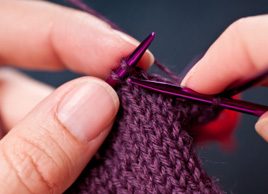How DIY can make you happy
We may not have to grow our own food or make our own clothes’but for a growing number of women, the act of creation has a powerful effect on our well-being. Find out how joining the DIY movement can make you a happier person

Source: Web exclusive: June 2009
When it comes to convenience, modern women (and men, for that matter) have it easy. We don’t need to know how to darn socks, sew a button, cook, garden or do much of anything tangible at all. Yet despite today’s ubiquity of easy convenience, many women have recently found themselves wandering back into the do-it-yourself arena. Whether it’s learning how to grow vegetables, make soap, sew, can, knit or bake, DIY has been growing faster than a squash in full sun (and what with all that cost savings, it’s growing even faster in these tough times).
Why all the DIY fuss? Turns out producing something all by yourself helps counteract many of our most persistent modern mental health afflictions, such as stress, meaninglessness and sadness, to name but a few. Nora Murphy, author of Knitting the Threads of Time, puts it more eloquently: ‘When we create something with our hands, we’re going back to the fundamentals. It’s about so much more than just the final product. We are tugging at the primal energies that bind us together here on Earth; we’re reconnecting with the purest and deepest form of life.’
Too warm and fuzzy? Well, for those of us who’ve dabbled in the DIY arts, even the hardened cynics, Murphy’s words ring surprisingly true. Here’s a run-down of how old-fashioned DIY skills can help give the modern woman a mental health boost.
Escape from stress
The process of producing something acts as a de-stresser. Why? Because it demands focus, which pulls your attention into the moment, distracting you from your everyday problems. Some DIY disciplines can relax you in other ways, too. Being outside in the dirt helping plants grow, for instance, is so healing that it’s spawned its own field of study, known as horticultural therapy. Meanwhile, mind-body expert Herbert Benson of Harvard University argues that those activities requiring repetitive actions, such as knitting, elicit what he calls the relaxation response’a feeling of calm that infiltrates your mind and body, a feeling most often associated with meditation.
Find your flow
When you become completely immersed in an activity to the extent that time passes without your even being aware of it, you’ve achieved what psychologist Dr. Mihaly Csikszentmihalyi calls flow. It’s most often associated with musicians and athletes, but crafting is also found to induce this state. The trick is to first find something that you’re passionate about; and second, shed yourself of the need for perfection, as that can completely destroy the joyful effects.
Find new friends
One complaint of modern living is feeling disconnected from your community. When you learn how to do something, you become part of a club of like-minded people, which opens up numerous opportunities to increase your social network. After all, as any student of the human condition knows, we are social beings and we feel better in the company of others. Whether it’s attending a knitting night, participating in a seed exchange event or taking an embroidery class, there are ample ways to meet people. Plus, there’s an explosion of DIY and crafting sites online that can link you up with global friends as well.
Connect to the past
Basic DIY skills used to be a simple reality of life’women could make bread, men could make stools. So when we, say, pick a perfectly ripe heirloom tomato from our tiny garden plots or balcony containers, we often feel a tug to the past, a strangely comforting assurance that we are part of a human continuum. It might be a memory of a grandparent or a passing thought about how women back then had to do this stuff just to survive, but the feeling is rather warm and it is kind of fuzzy’it’s peaceful. ‘Just last night,’ says Murphy, ‘a woman at a book club I visited told me about a quilt a friend of hers made for her. This friend passed away 20 years ago. Yet, whenever she wraps herself in this old quilt, she truly senses the powerful presence of her old friend.’
Accomplish something real
Rarely are people today offered the chance to see a project through from beginning to end. Most of our jobs require us to act in the middle of the process, forcing us to imagine why we are useful and to mentally visualize the fruits at the end of our labour. Not so with DIY. The sense of accomplishment is immediate and profound‘we can hold it, eat it, wear it or show it off’and that’s why the act of creating is so addictive.
How do you DIY?
I’ll never forget the joy on my four-year-old daughter’s face when I made her a skirt. I hadn’t sewn anything since high school. But after completing a 10-hour intro to sewing workshop, I brought her to the fabric store, where she chose the material (surprisingly, decorated with tiny cars rather than pink flowers) with which I would construct a simple A-line pattern. Then I cut it out, pinned it up and stitched it. She wore it for three days straight. She kept saying thank you. She giggled. I told her stories of how Grandma used to make my Halloween costumes, which then gave me the warm and fuzzies. All that, and it took just one afternoon.
Are you getting a joy boost from DIY? Post your stories in the comments below.
Don’t miss out! Sign up for our free weekly newsletters and get nutritious recipes, healthy weight-loss tips, easy ways to stay in shape and all the health news you need, delivered straight to your inbox.




